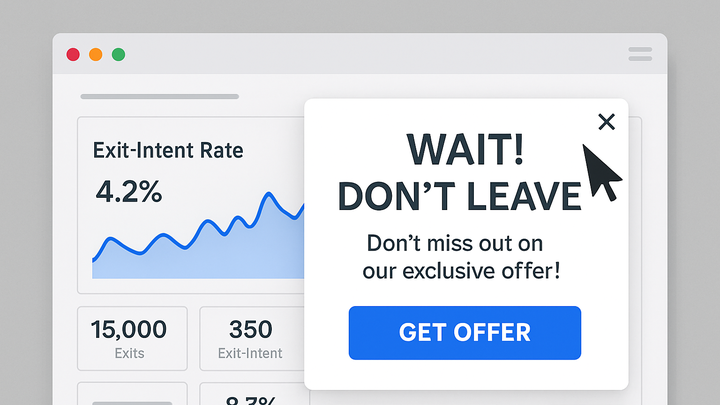Published on 2025-06-22T07:42:11Z
What is Exit Intent? Examples of Exit Intent
Exit Intent refers to the detection of visitor behaviors—like moving the mouse toward the close button, rapid scrolls to the top, or periods of inactivity—that signal an imminent page exit. In web analytics, tracking exit intent helps marketers and UX designers deploy timely interventions (e.g., pop-ups, special offers, surveys) to reduce bounce rates and recover potential conversions. Tools like PlainSignal (a cookie-free analytics solution) and Google Analytics 4 (GA4) allow you to capture exit-intent events and analyze them alongside broader engagement metrics. Implementing exit intent typically involves adding JavaScript event listeners or leveraging built-in triggers in your analytics platform.
Example PlainSignal tracking code:
<link rel="preconnect" href="//eu.plainsignal.com/" crossorigin />
<script defer data-do="yourwebsitedomain.com" data-id="0GQV1xmtzQQ" data-api="//eu.plainsignal.com" src="//cdn.plainsignal.com/plainsignal-min.js"></script>
GA4 custom event for exit intent:
gtag('event', 'exit_intent', {
'event_category': 'engagement',
'event_label': 'Exit Intent Triggered'
});
Exit intent
Exit intent identifies when a user is about to leave a website, enabling timely interventions like pop-ups to recover potential conversions.
Understanding Exit Intent
Exit intent refers to techniques for detecting when a visitor is about to leave your website. This involves monitoring behavior cues and patterns that suggest imminent departure.
-
Behavioral triggers
Common user actions that signal exit intent.
-
Mouse movement toward close button
Detects when the cursor moves rapidly toward the browser’s close, back, or address bar area.
-
Rapid scroll up
Identifies when a user scrolls quickly to the top of the page, often prepping to leave.
-
Inactivity timeout
Flags users who pause interaction for a set period, indicating possible disengagement.
-
-
Implementation methods
Technical approaches for capturing exit intent events.
-
Javascript event listeners
Uses
mouseleaveormouseoutevents to detect cursor exit from viewport. -
Scroll depth detection
Monitors scroll position to trigger exit intent when users move upward past a threshold.
-
Inactivity timers
Sets timers to track user inactivity and triggers when no interaction occurs within a duration.
-
Why Track Exit Intent?
Monitoring exit intent allows teams to deploy targeted interventions before visitors leave, improving engagement and conversions.
-
Prevent abandonment
Intervene with offers or messages to keep visitors engaged at the point of exit.
-
Boost conversions
Recover potential sales or sign-ups by catching users before they leave.
-
Enhance user experience
Provide timely, relevant content that addresses user needs and reduces frustration.
Implementing Exit Intent with PlainSignal and GA4
Walkthrough for adding exit intent tracking using PlainSignal’s cookie-free analytics and creating custom events in GA4.
-
PlainSignal integration
Add PlainSignal’s script to your site to automatically capture exit intent events.
-
Tracking code snippet
<link rel="preconnect" href="//eu.plainsignal.com/" crossorigin /> <script defer data-do="yourwebsitedomain.com" data-id="0GQV1xmtzQQ" data-api="//eu.plainsignal.com" src="//cdn.plainsignal.com/plainsignal-min.js"></script>
-
-
GA4 custom event
Set up a custom
exit_intentevent in Google Analytics 4 to tag and measure exit intent triggers.-
GA4 event code
gtag('event', 'exit_intent', { 'event_category': 'engagement', 'event_label': 'Exit Intent Triggered' });
-
Analyzing Exit Intent Data
Best ways to interpret exit intent metrics to inform marketing and UX decisions.
-
Exit intent rate
The percentage of sessions where exit intent was detected.
-
Popup conversion rate
Conversion rate of visitors who saw an exit-intent pop-up.
-
Audience segmentation
Break down exit intent events by user segments like device type or referral source.
Best Practices and Common Pitfalls
Guidelines to ensure exit intent triggers help rather than harm the user experience.
-
Timing and frequency
Avoid overly aggressive triggers; test delays and thresholds to find the right balance.
-
Message relevance
Tailor pop-up offers or messages to user context and behavior.
-
Mobile considerations
Use alternative triggers (e.g., scroll or inactivity) as hover-based exit intent may not work on touchscreens.
